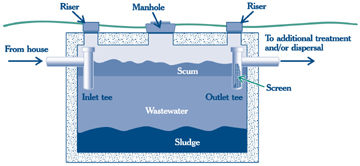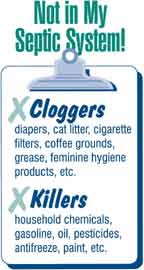
Septic Systems
Maintaining Your Septic System
Conscientious maintenance of your septic system is one of the most critical steps you can take to protect your lake. A septic system is a two-step process to treat human wastes.Septic Systems
Proposed Septic System
Ordinance
March 1, 2010 City meeting - Attended by Mayor Lori Hollingsworth, DLWID Chair
Brian Green, City Councilor Chester Noreikis, City Councilor Gary Ellingson,
City Manager David Hawker, Lake Manager Paul Robertson, DLWID intern Seth Lenaerts
1. All properties
in the watershed on city water without sewer would be required to have an
inspection every ten years for continued water service.
2. The time frame of the initial inspection would be defined by ordinance and
would be sequential considering the type of tank listed in the county record,
age, distance from the lake, and if there was no record with the county. By
way of example only:
Year one - all systems bordering the lake, for which there is no county record
or the record indicates a steel tank older than 10 years.
Year two - all other systems in the watershed where there is no county record
or the record shows a tank older than 25 years.
Year three - all other systems in the watershed where the county record shows
the tank older than 15 years.
Year four - all systems in the watershed older than ten years.
This is simply an example. The sequence in the ordinance will be defined by
further discussions, based on any available science on failure trends, and
to balance the actual load. It is anticipated that the ordinance itself will
list each property covered, and the year of the required inspection. A delay
of one year will be permitted for good cause shown.
3. The next inspection for the properties will be ten years after the year
the first inspection is required.
4. The inspection will be done by a contractor selected by the City with due
consideration on the recommendation of the DLWID. It is anticipated that this
will be a private contractor selected based on the response to a request for
proposals, and considering price, availability, qualifications, and reference
checks.
5. The RFP will be prepared jointly by the City and DLWID, and will include
the specific inspection requirements. It is anticipated that the annual inspections
will occur only during two months (August and September) which will allow a
better inspection and lower cost.
6. The inspection will include pumping the tank only if the inspector determines
it is beneficial based on a physical inspection, available records of the last
pumping, and average annual water consumption.
7. Copies of the inspection report will go to the property owner, County, DLWID
and City.
8. Additional public input, outside of the two public comment periods at City
Council meetings and DLWID board meetings will be organized by DLWID.
|
Septic Systems Maintaining Your Septic System Conscientious maintenance of your septic system is one of the most critical steps you can take to protect your lake. A septic system is a two-step process to treat human wastes. |
The wastes flow into a tank where the solids settle out. The liquids then flow into a drainfield or another type of system where they are decomposed by soil microbes. These wastes are very high in nutrients.
|
 |
When putting in a new septic system, keep these steps in mind:
• make sure it is the right size for your household
• keep it at least 100 feet from the lake
• install a second drainfield when possible
• hire only quality contractors
Once installed, these steps will help protect your lake:
• keep the drainfield clear
• clean the septic system regularly and have it inspected every one to
two years
• avoid or limit the use of toxic chemicals in the home
Daily actions can be taken to help your septic system work less:
• avoid using a garbage disposal; compost food wastes instead
• avoid chemical products for your septic that boast less-frequent tank
pumping. (these products can add excess nutrients to the lake by liquefying
more of
the sludge)
• many of the steps you take to protect your lake-such as conserving water-also
help keep your septic system operating efficiently and for a long period of
time
Reference: Septic Systems and Water Quality
by the Tip of the Mitt Watershed Council
(3-fold brochure): order for 50 cents each (which includes postage) from PO Box
300, Conway, MI 49722, or call 616/347-1181.
Information is from "Your lake and you!" published by the North
American Lakes
Management Society (NALMS) www.nalms.org.
Items
that you can do to prevent having to replace your septic system, save money,
and improve the environment - all at the same time.
1. CONTROL VOLUME INTO SEPTIC TANK - Reduce WASTE and WATER
Reduce water. Install low volume toilets. Low flow shower heads.
Space out laundry loads and showers - or any large water usages.
Septic systems need time to eliminate the water you put in.
Reduce the waste. Eliminate garbage disposals.
2. SEPTIC PUMPING - Yes - have it pumped as needed. According to the Lincoln
County Sanitarian, pump the tank only when needed. A septic system is like a
garden. It takes time to grow the right balance of bacteria in a septic tank
that is needed to properly digest waste. Pumping removes the bacteria, and it
can take a long time to restore the bacteria level for the septic tank to function
at maximum capacity.
Pump more
frequently if:
Garbage disposal in house - Pump every 1 to a 1/2 years
More people live in the house than it was originally built for.
Frequent use of laundry due to occupation (construction etc.) or
children.
If a water softener is installed.
If you know that you have a small septic tank.
T&L Septic Tank Service -
994-9950, watch for discounts with DLWID & PADL
 |
3. DON'T
PUT DOWN THE DRAIN - Drain cleaners that unclog drains. Use hot water instead. Large amount of bleaches. It kills bacteria. Grease, cooking fats. Very slow dissolving. Cleaning paint brushes or waste water from latex paints. Never dissolves. Kleenex type tissues, wet strength towels. (Cotton fibers?) Slow dissolving. NO plastics, vinyls, rubber, cloths. NO non-degradable items - ever Coffee grounds, cigarette butts, diapers. Builds up in tank. Don't use cheap laundry soaps with filler in them. Prefer liquid soaps. |
4. Your
SEPTIC DRAINFIELDS
Map them. Find out where they are at. Find out capacity of your tank.
Don't drive or allow heavy vehicles to cross over drain fields.
Don't cover drainfield with asphalt, concrete, or driveway. Use grass.
Don't plant trees and shrubs that will root over drain fields.
Do divert water from roofs and drainage away from drain fields.
5. UPGRADING YOUR SEPTIC SYSTEM
Replace your septic tank with a large capacity tank - it won't have to be pumped
as often.
6. BUYING A HOUSE? Get the whole system inspected (not just a flow test)
and insist that septic pumping is current before you buy. (Local septic companies
keep records, and possibly, permit records available at County). Don't buy
someone else's problems.
www.deq.state.or.us/programs/consumercorner
Government
Aims to Cut Impact of Septic Systems
CIVITAS2004-Sustainable Development News
04/03/03
WASHINGTON, DC, USA, April 1, 2003 - The US Environmental Protection Agency (EPA)
is providing approximately 4,000 city and county public health officials with
materials to continue efforts to educate citizens about proper septic system
management to prevent pollution from entering rivers, lakes, coasts, and groundwater.
According to the federal agency, failing and improperly managed septic systems
are a significant source of water pollution, potentially causing contamination
of drinking water wells or restricting shellfish harvest. Septic systems serve
approximately 25 percent of US households, and one in every three new homes built
today uses these systems.
"Public education is the key to improving septic system
management. Citizens need to better understand the potential harm improperly
managed septic systems can have on the environment and public health and what
they can do to help," said EPA Assistant Administrator for Water, G. Tracy
Mehan, III.
The Agency has developed a CD-based kit that communities can
use to reach out to citizens. Using the CD, communities can inexpensively produce
customized versions of brochures, utility bill inserts, and other useful information.
Each document contains space where communities can add local information, so
citizens will know how to obtain additional information.
To order copies of the Wastewater Month CD or hard copies of
these materials, visit the Wastewater Month website at www.epa.gov/npdes/wastewatermonth or
contact Nikos Singelis, of the Office of Wastewater Management, at singelis.nikos@epa.gov.
Graphics: Septic system (Environmental Protection Agency), Septic tank (Environmental
Protection
Agency)
site map
home
Copyright © 2003-2011 Preservation Association of Devils
Lake (PADL).
All rights reserved.
P.O. Box 36
Lincoln City, OR 97367
PADLsteward@wcn.net